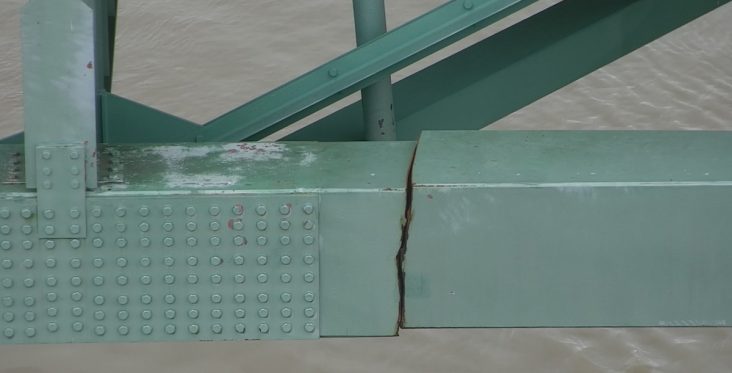Officials still unsure what caused I-40 bridge fracture
by August 5, 2021 5:03 pm 1,123 views

The structural crack on the Interstate 40 Mississippi River Bridge between Memphis and West Memphis.
Why did a primary support beam on the Interstate 40 bridge that connects West Memphis to Memphis fracture and lead to a near collapse of the busiest freight bridge in the United States? It’s a mystery that officials in Arkansas and Tennessee still don’t have answers to even after repair work on the bridge was completed and east and westbound lanes reopened this week.
Arkansas Department of Transportation Public Information Officer Dave Parker tells Talk Business & Politics the damaged beam that led to the emergency and immediate closure of the bridge on May 11 has been sent off for forensic analysis. Parker said officials are not sure when analysis will be completed.
Sensors are being used to monitor the bridge in the wake of the repairs.
The flow of traffic has resumed on the bridge, but it’s too early to know if the same number of vehicles – about 41,000 per day – are still using the bridge, Parker said. The bridge is scheduled for a fall inspection and will move forward as planned, Parker said even though the bridge has been inspected numerous times in recent weeks.
Before it was reopened, sensors monitored as load tests were conducted. Parker said there were no problems when the bridge was load tested and it led to the bridge re-opening.
The initial fracture spot on a primary support beam had to be repaired with specially made steel plates. About 500 “weld spots” were performed by workers. Each spot had to be inspected and about 10 spots needed additional work. Parker said there are sensors located in the bridge that monitor it.
“Some of the instrumentation that ARDOT’s consultant installed as part of the repairs currently remains active on the bridge. The currently active instrumentation includes strain gauges on both the north and south tie girders, strain gauges on multiple laterals, and strain gauges on the arch near T22N,” he said. “That system was used for the live load tests. The strain gauge monitoring system is solar powered and will remain active.”
ArDOT and the Tennessee Department of Transportation share responsibilities for maintaining the bridge. ArDOT is responsible for inspections, while TDOT is responsible for maintenance and repairs, and the states share the costs.
A visible crack was spotted when the bridge was shut down. Several pictures have surfaced from kayakers and boaters that showed the fracture had formed years earlier, and may have started to form as early as 2016.
The inspector in charge of performing yearly inspections was fired and has reportedly been the subject of a potential criminal probe. When asked about the status of that probe, Parker said he wasn’t sure.
“At this time, we have not been informed of any criminal charges that have been filed. This issue was turned over to the USDOT Office of Inspector General and the investigation is ongoing,” Parker said.
The national flow of goods from north to south and from east to west came to a standstill when the bridge was initially shut down. Despite efforts to re-route traffic onto the I-55 bridge, the economic consequences were devastating to West Memphis, the surrounding communities and the trucking industry.
West Memphis officials estimate the city’s sales tax collections have dropped by 25% since the closure, and re-routed traffic has damaged and choked off streets throughout the largest city in Crittenden County.
Initially, the trucking industry estimated it was losing about $2.4 million per day, but changes made last month to improve traffic flow and delay times on the I-55 bridge reduced that estimate to $900,000 per day.
